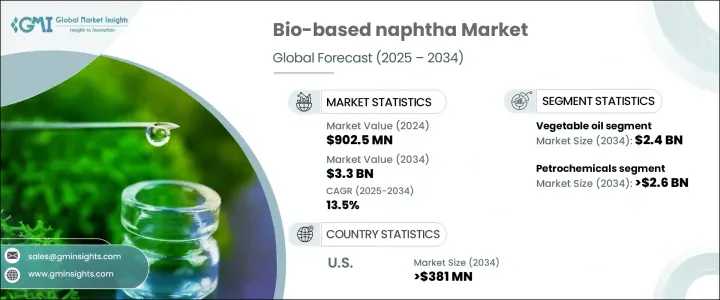
|
시장보고서
상품코드
1716579
바이오 기반 납사 시장 : 기회, 성장 촉진요인, 산업 동향 분석 및 예측(2025-2034년)Bio-based Naphtha Market Opportunity, Growth Drivers, Industry Trend Analysis, and Forecast 2025 - 2034 |
||||||
세계의 바이오 기반 납사 시장 규모는 2024년 9억 250만 달러로 평가되었고, 2025년부터 2034년까지 연평균 성장률(CAGR) 13.5%로 성장할 것으로 예측됩니다.
이러한 빠른 성장은 여러 산업 분야에서 지속 가능한 연료 대체제에 대한 수요가 증가함에 따라 촉진되고 있습니다. 전 세계 기업과 정부가 탄소 중립과 청정 에너지원을 강조하면서 바이오 기반 납사가 기존 화석 연료를 대체할 수 있는 대안으로 떠오르고 있습니다. 식물성 오일과 바이오매스와 같은 재생 가능한 자원에서 추출되는 이 친환경적인 대안은 운송, 석유화학, 플라스틱 제조와 같은 산업에서 점점 더 많이 채택되고 있습니다. 온실가스 배출량을 줄이기 위한 전 세계적인 노력과 엄격한 환경 규제는 바이오 기반 납사의 채택 증가에 크게 기여했습니다.

최근 몇 년 동안 주요 업계 기업과 정책 입안자들은 지속 가능성 목표를 달성하기 위해 재생 가능한 공급 원료에 대한 투자를 가속화했습니다. 기업들은 바이오 기반 납사의 낮은 탄소 배출량과 기존 정유 및 석유화학 인프라와의 호환성을 활용하여 생산 모델을 통합하는 방향으로 전환하고 있습니다. 환경 문제에 대한 인식이 높아지고 바이오 기반 연료의 경제적 이점이 부각되면서 시장 확대가 더욱 가속화되고 있습니다. 또한 정제 기술의 발전과 바이오 기반 제품에 대한 정부 보조금 증가로 바이오 납사에 대한 접근성과 비용 효율성이 향상되어 더 많은 채택을 장려하고 있습니다.
| 시장 범위 | |
|---|---|
| 시작 연도 | 2024년 |
| 예측 연도 | 2025-2034년 |
| 시작 금액 | 9억250만 달러 |
| 예측 금액 | 33억 달러 |
| CAGR | 13.5% |
바이오 기반 납사 시장은 주로 식물성 오일과 바이오매스 기반 공급원으로 분류됩니다. 제조업체들은 다른 바이오매스 공급원에 비해 조달이 용이하고 환경에 미치는 영향이 적기 때문에 식물성 오일을 선호합니다. 납사 생산에 식물성 오일을 사용하면 플라스틱과 화학물질의 탄소 발자국을 줄일 수 있어 지속 가능성 목표를 달성하려는 기업에게 매력적인 공급 원료 옵션이 됩니다.
용도별로는 석유화학 부문이 2025년부터 2034년까지 연평균 12%의 성장률을 보이며 2034년까지 26억 달러의 가치를 창출할 것으로 예상됩니다. 석유화학 생산에서 바이오 기반 납사의 사용이 증가하는 이유는 기존 생산 시설에 원활하게 통합하면서 탄소 배출을 줄일 수 있기 때문입니다. 제조업체들은 엄격한 환경 규제를 준수하고 친환경 제품에 대한 수요 증가에 부응하기 위해 바이오 기반 납사로 적극적으로 전환하고 있습니다. 이러한 전환은 장기적인 산업 성장을 지원하는 동시에 기업이 글로벌 지속가능성 벤치마크를 충족하도록 돕습니다.
미국의 바이오기반 납사 시장은 2025년부터 2034년까지 연평균 성장률(CAGR) 12%로 성장하여 2034년에는 3억 8,100만 달러에 달할 것으로 예측됩니다. 미국은 재생 에너지원의 강력한 생산과 소비에 힘입어 바이오 연료 부문에서 여전히 지배적인 위치를 차지하고 있습니다. 에탄올, 바이오디젤, 식물성 오일과 폐기물에서 추출한 재생 디젤과 같은 바이오 연료에 대한 의존도가 높아지면서 미국 내 바이오 기반 납사의 확대에 크게 기여하고 있습니다. 정부의 인센티브와 엄격한 환경 정책의 채택은 시장 성장을 더욱 뒷받침하여 미국이 바이오 기반 납사 혁신 및 개발의 핵심 허브로 자리매김하고 있습니다.
목차
제1장 조사 방법과 조사 범위
제2장 주요 요약
제3장 업계 인사이트
- 생태계 분석
- 밸류체인에 영향을 주는 요인
- 이익률 분석
- 혁신
- 장래의 전망
- 제조업체
- 유통업체
- 공급자의 상황
- 이익률 분석
- 주요 뉴스
- 규제 상황
- 영향요인
- 성장 촉진요인
- 재생 디젤 및 연료에 대한 수요 증가
- 바이오 플라스틱 및 엘라스토머 시장의 확장
- 업계의 잠재적 위험 및 과제
- 원자재 가격 변동
- 성장 촉진요인
- 성장 가능성 분석
- Porter's Five Forces 분석
- PESTEL 분석
제4장 경쟁 구도
- 소개
- 기업 점유율 분석
- 경쟁 포지셔닝 매트릭스
- 전략 전망 매트릭스
제5장 시장 규모와 예측 : 공급원별(2021-2034년)
- 주요 동향
- 식물성 오일
- 바이오매스
제6장 시장 규모와 예측 : 용도별(2021-2034년)
- 주요 동향
- 석유화학
- 가솔린
- 바이오벤젠
- 바이오페놀
- 기타
제7장 시장 규모와 예측 : 다운스트림 용도별(2021-2034년)
- 주요 동향
- 바이오 폴리에틸렌(바이오PE)
- 바이오 폴리프로필렌(바이오PP)
- 바이오 폴리염화비닐(바이오PVC)
- 기타
제8장 시장 규모와 예측 : 지역별(2021-2034년)
- 주요 동향
- 북미
- 미국
- 캐나다
- 유럽
- 영국
- 독일
- 프랑스
- 이탈리아
- 스페인
- 러시아
- 아시아태평양
- 중국
- 인도
- 일본
- 한국
- 호주
- 라틴아메리카
- 브라질
- 멕시코
- 중동 및 아프리카
- 남아프리카
- 사우디아라비아
- 아랍에미리트(UAE)
제9장 기업 프로파일
- Diamond Green Diesel
- Eni
- Euglena
- Gevo
- Kaidi Finland
- Neste
- Phillips 66
- Repsol
- Shell
- UPM Biofuels
The Global Bio-Based Naphtha Market was valued at USD 902.5 million in 2024 and is projected to grow at a CAGR of 13.5% between 2025 and 2034. This rapid expansion is fueled by the rising demand for sustainable fuel alternatives across multiple industries. As businesses and governments worldwide emphasize carbon neutrality and cleaner energy sources, bio-based naphtha is emerging as a viable replacement for traditional fossil fuels. Derived from renewable sources like vegetable oils and biomass, this eco-friendly alternative is increasingly adopted by industries such as transportation, petrochemicals, and plastics manufacturing. The global push toward reducing greenhouse gas emissions, combined with stricter environmental regulations, has significantly contributed to the growing adoption of bio-based naphtha.

In recent years, major industry players and policymakers have accelerated investments in renewable feedstocks to meet sustainability targets. Companies are shifting their production models to integrate bio-based naphtha, leveraging its lower carbon footprint and compatibility with existing refining and petrochemical infrastructure. The growing awareness of environmental issues and the economic benefits of bio-based fuels further strengthen the market's expansion. Additionally, advancements in refining technology and increasing government subsidies for bio-based products have made bio-naphtha more accessible and cost-effective, thereby encouraging wider adoption.
| Market Scope | |
|---|---|
| Start Year | 2024 |
| Forecast Year | 2025-2034 |
| Start Value | $902.5 Million |
| Forecast Value | $3.3 Billion |
| CAGR | 13.5% |
The bio-based naphtha market is categorized primarily into vegetable oil and biomass-based sources. The vegetable oil segment is anticipated to reach USD 2.4 billion by 2034, driven by the abundance and renewable nature of vegetable oils. Manufacturers prefer vegetable oils due to their ease of sourcing and lower environmental impact compared to other biomass sources. The use of vegetable oils in naphtha production helps reduce the carbon footprint of plastics and chemicals, making them an attractive feedstock option for businesses aiming to achieve sustainability goals.
In terms of application, the petrochemical segment is expected to grow at a CAGR of 12% between 2025 and 2034, generating USD 2.6 billion by 2034. The increasing use of bio-based naphtha in petrochemical production is largely attributed to its ability to reduce carbon emissions while seamlessly integrating into existing production facilities. Manufacturers are actively transitioning to bio-based naphtha to comply with stringent environmental regulations and cater to the rising demand for greener products. This shift supports long-term industry growth while helping companies meet global sustainability benchmarks.
U.S. bio-based naphtha market is forecasted to grow at a CAGR of 12% between 2025 and 2034, reaching USD 381 million by 2034. The United States remains a dominant player in the biofuels sector, benefiting from its robust production and consumption of renewable energy sources. The increasing reliance on biofuels such as ethanol, biodiesel, and renewable diesel-sourced from vegetable oils and waste products-has significantly contributed to the expansion of bio-based naphtha in the country. Government incentives and the adoption of stringent environmental policies further support market growth, positioning the U.S. as a critical hub for bio-based naphtha innovation and development.
Table of Contents
Chapter 1 Methodology & Scope
- 1.1 Market scope & definition
- 1.2 Base estimates & calculations
- 1.3 Forecast calculation
- 1.4 Data sources
- 1.4.1 Primary
- 1.4.2 Secondary
- 1.4.2.1 Paid sources
- 1.4.2.2 Public sources
Chapter 2 Executive Summary
- 2.1 Industry synopsis, 2021-2034
Chapter 3 Industry Insights
- 3.1 Industry ecosystem analysis
- 3.1.1 Factor affecting the value chain
- 3.1.2 Profit margin analysis
- 3.1.3 Disruptions
- 3.1.4 Future outlook
- 3.1.5 Manufacturers
- 3.1.6 Distributors
- 3.2 Supplier landscape
- 3.3 Profit margin analysis
- 3.4 Key news & initiatives
- 3.5 Regulatory landscape
- 3.6 Impact forces
- 3.6.1 Growth drivers
- 3.6.1.1 Growing demand for renewable diesel & fuel
- 3.6.1.2 Expansion of the bioplastics & elastomers market
- 3.6.2 Industry pitfalls & challenges
- 3.6.2.1 Fluctuating prices of raw materials
- 3.6.1 Growth drivers
- 3.7 Growth potential analysis
- 3.8 Porter's analysis
- 3.9 PESTEL analysis
Chapter 4 Competitive Landscape, 2024
- 4.1 Introduction
- 4.2 Company market share analysis
- 4.3 Competitive positioning matrix
- 4.4 Strategic outlook matrix
Chapter 5 Market Size and Forecast, By Source, 2021-2034 (USD Billion) (Kilo Tons)
- 5.1 Key trends
- 5.2 Vegetable oils
- 5.3 Biomass
Chapter 6 Market Size and Forecast, By Application, 2021-2034 (USD Billion) (Kilo Tons)
- 6.1 Key trends
- 6.2 Petrochemicals
- 6.3 Gasoline
- 6.4 Bio benzene
- 6.5 Bio phenol
- 6.6 Others
Chapter 7 Market Size and Forecast, By Downstream Application, 2021-2034 (USD Billion) (Kilo Tons)
- 7.1 Key trends
- 7.2 Bio polyethylene (Bio-PE)
- 7.3 Bio polypropylene (Bio-PP)
- 7.4 Bio polyvinyl chloride (Bio-PVC)
- 7.5 Others
Chapter 8 Market Size and Forecast, By Region, 2021-2034 (USD Billion) (Kilo Tons)
- 8.1 Key trends
- 8.2 North America
- 8.2.1 U.S.
- 8.2.2 Canada
- 8.3 Europe
- 8.3.1 UK
- 8.3.2 Germany
- 8.3.3 France
- 8.3.4 Italy
- 8.3.5 Spain
- 8.3.6 Russia
- 8.4 Asia Pacific
- 8.4.1 China
- 8.4.2 India
- 8.4.3 Japan
- 8.4.4 South Korea
- 8.4.5 Australia
- 8.5 Latin America
- 8.5.1 Brazil
- 8.5.2 Mexico
- 8.6 MEA
- 8.6.1 South Africa
- 8.6.2 Saudi Arabia
- 8.6.3 UAE
Chapter 9 Company Profiles
- 9.1 Diamond Green Diesel
- 9.2 Eni
- 9.3 Euglena
- 9.4 Gevo
- 9.5 Kaidi Finland
- 9.6 Neste
- 9.7 Phillips 66
- 9.8 Repsol
- 9.9 Shell
- 9.10 UPM Biofuels




















